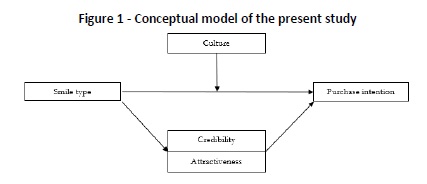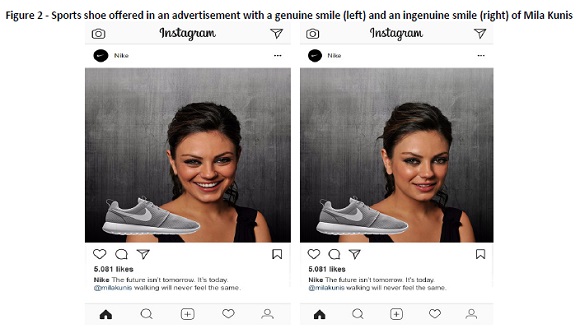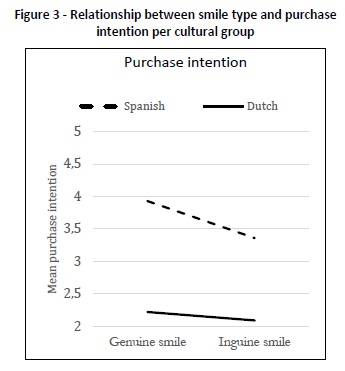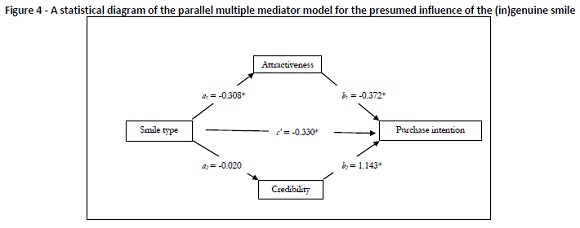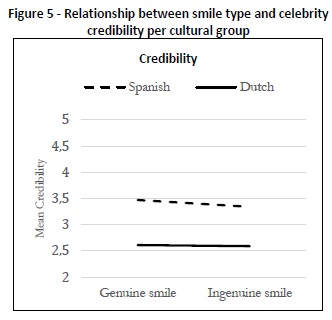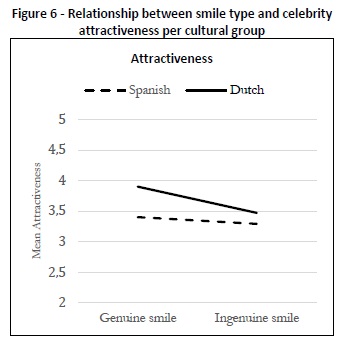Serviços Personalizados
Journal
Artigo
Indicadores
-
 Citado por SciELO
Citado por SciELO -
 Acessos
Acessos
Links relacionados
-
 Similares em
SciELO
Similares em
SciELO
Compartilhar
Tourism & Management Studies
versão impressa ISSN 2182-8458versão On-line ISSN 2182-8466
TMStudies vol.15 no.4 Faro dez. 2019
https://doi.org/10.18089/tms.2019.150403
MANAGEMENT: SCIENTIFIC PAPERS
The cross-cultural impact of the ingenuine smiling celebrity in online advertising
El impacto intercultural de la ingeniosa celebridad sonriente en la publicidad en línea
Peter Broeder*, Daphne Goorden*
*Tilburg University, Dept. Communication and Cognition, the Netherlands, peter@broeder.com
**Tilburg University, Dept. Communication and Cognition, the Netherlands
ABSTRACT
Promoting products via Instagram is a rapidly growing phenomenon in the world of online advertising. Standing out with these advertisements and obtaining desired consumer outcomes becomes increasingly challenging due to the enormous amount of advertisements that already have been implemented on this platform. One strategy that could be used is celebrity endorsement, which is a tactic that is - considering celebrities’ credible and attractive characteristics - proven to be effective for creating favourable attitudes and higher purchase intentions. The present study investigated the effect of an (in)genuine smiling celebrity on consumer behaviour in an Instagram advertisement. Specifically, this study addressed differences between consumers from two cultures: the Netherlands and Spain. An online experiment with two conditions was conducted (ingenuine vs. genuine smiling celebrity). There were 174 Dutch and 137 Spanish participants. The results revealed that smile type did affect consumers’ purchase intention. Attitudes towards the celebrity influenced the effect of smile type on purchase intention. Cultural background did play a moderating role.
Keywords: Consumer behaviour, online advertising, persuasion marketing, celebrities, cross-cultural, Instagram.
RESUMEN
La promoción de productos a través de Instagram es un fenómeno en muy crecimiento en el mundo de la publicidad en línea. Destacar con estos anuncios y obtener los resultados deseados para el consumidor se vuelve cada vez más desafiante debido a la enorme cantidad de anuncios que ya se han implementado en esta plataforma. Una estrategia que podría usarse es el respaldo de las celebridades, que es una táctica que, teniendo en cuenta las características creíbles y atractivas de las celebridades, ha demostrado ser efectiva para crear actitudes favorables e intenciones de compra más altas. El presente estudio investigó el efecto de una (in)genuina celebridad sonriente en el comportamiento del consumidor en un anuncio de Instagram. Específicamente, este estudio abordó las diferencias entre los consumidores de dos culturas: los Países Bajos y España. Se llevó a cabo un experimento en línea con dos condiciones (ingenio versus celebridad sonriente genuina). Este studio tuvo 174 participantes holandeses y 137 españoles. Los resultados revelaron que el tipo de sonrisa afectaba la intención de compra. Las actitudes hacia la celebridad influent el efecto del tipo de sonrisa en la intención de compra. Los antecedentes culturales jugaron un papel moderador.
Palabras clave: Comportamiento del consumidor, publicidad en línea, marketing de persuasión, celebridades, intercultural, Instagram.
1. Introduction
Celebrity endorsed advertisements have not only been a phenomenon in more traditional settings. By collaborating with celebrities in online platforms, such as Facebook, Twitter, Instagram, and YouTube, marketers reach an enormous audience because generally, celebrities possess large numbers of followers. Celebrities are capable of grabbing consumers’ attention and conveying a sense of trust, which makes them attractive for marketers to use in their marketing communications (Muda, Musa, and Putit, 2017).
For an online environment, in particular, the face of the celebrity generates higher engagement (Bakhshi, Shamma, and Gilbert, 2014). Consumers experiencing similar emotions as the ones that are expressed in an online advertisement (i.e., ‘mimicking facial expressions’) are likely to have positive attitudes towards the advertisement as well (Lewinski, Fransen, and Tan, 2014). Subsequently, these emotions may lead to greater behavioral intentions (Kemp, Bui, and Chapa, 2012). One specific facial expression that elicits positive consumer behaviour is the smile (Kulczynski, Ilicic, and Baxter, 2016). An intriguing feature that has not yet been investigated is the authenticity of the celebrity smile: Does the consumer perceive whether a celebrity is showing a genuine smile (or not)? In addition, through culturally specific experiences, ingenuine smiles could appear and be perceived as genuine (and reversed). This might increase the risk of varying consumer behaviour (Weker, 2016; Choi & Lewis, 2017). While a number of studies investigated the effects of smiles on consumers mostly in service industries (e.g., Otterbring, 2017), none integrated the potential effect of celebrity endorsers’ smiles in online advertising settings yet. The present study examines celebrity endorsed advertisements on Instagram and to what extent the exposure of genuine vs. ingenuine smiles influences consumer attitudes and behavioural intentions. A comparison is made of consumers from two different cultures: the Netherlands and Spain.
2. Hypothesis development
2.1 Genuine and ingenuine smiles
According to Ekman and Davidson (1990) a genuine smile (or Duchenne smile) refers to a spontaneous expression of true enjoyment (the emotion happiness) that involves the activation of the two most dominant facial muscles. In the periocular region the facial muscles that pull the outer corners of the eyebrows slightly downwards produce bagging below the eyes and form wrinkles to the corner of the eyes. These facial muscles are called Action Unit 6 (AU6). In the cheek region the Action Unit 12 (AU12) related muscles draw both lip corners up towards the cheekbones. In contrast, an ingenuine smile (or non-Duchenne smile) neither expresses enjoyment nor activates both facial muscles at the same time (often, only AU 12 is slightly activated). In other words, the Duchenne smile occurs particularly when someone generates the smile uncontrollably and unconsciously.
Frank and Ekman (1993) proposed that an individual exposing a genuine smile will observe positive emotions such as happiness, pleasure, amusement, interest, and surprise. This is confirmed by findings of Gunnery and Ruben (2016) and llicic, Kulczynski, and Baxter (2018). Celebrity endorsers exposing a genuine smile were perceived as more genuine and more persuasive, than individuals expressing ingenuine smiles. Remarkably, genuine smiles can also be produced on purpose. Weker (2016) found that genuine smiles indeed can be ‘trained’, which means that celebrities intentionally can activate the lines around the eyes in such a way that their false smiles appear as genuine. This implies that genuine smiles do not merely occur when someone experiences true enjoyment and can even occur in online situations with non-positive emotions (Krumhuber & Manstead, 2009).
Several studies on consumer behaviour noted a positive effect of genuine smiles on purchase intention. Celebrity endorsers, in particularly, have been shown to elicit a positive attitude towards the product they are endorsing (Peace, Miles, and Johnston, 2006) and to draw more attention to products (Wang, Cheng, and Chu, 2017). Genuine smiling endorsers were capable of producing consumer joy and more positive attitudes towards the overall advertisement compared to non-smiling endorsers (Scanlon & Polage, 2011; Berg, Söderlund, and Lindström, 2015). The study by Ilicic, Kulczynski, and Baxter, (2016) also revealed that when consumers had negative attitudes towards the celebrity endorser (and in turn: the product), smiles were able to improve consumers’ attitudes towards both the endorser and the product. Hence, the following hypothesis is formulated:
Hypothesis 1: A genuine smiling celebrity has a positive behavioural effect on consumers.
2.2 Attractiveness and credibility
Physical attractiveness could be considered the most determinant factor for celebrity endorsers in an advertising context to get the desired attention and interest from the online consumer (Agam, 2017). Thomas and Johnson (2016) found that a higher degree of attractiveness indeed related to higher purchase intentions, but that this effect is mediated by how consumers perceive the overall advertisement. Likewise, Dom, Ramli, Chin, and Fern (2016) discovered that when an attractive celebrity was used in an advertisement, consumers’ impressions about the product were positive before even looking at it. Golle, Mast, and Lobmaier (2014) identified that facial expressions are an imperative part of perceiving someone as attractive. Specifically, smiling individuals (vs. non-smiling individuals) did not only compensate for judgments of unattractiveness, but they were also capable of strengthening the observer’s positive emotions. Facial beauty (e.g., geometry of the face, emotional expressions, skin health, gender/femininity) also received major attention in research on physical appearance. Little (2014) pointed out that not all facial characteristics are perceived as universally attractive, and that varying opinions always occur based on someone’s personal preferences. The following hypothesis is formulated:
Hypothesis 2: Celebrity attractiveness influences the relationship between smile type and behavioural intention.
Another characteristic that makes celebrities influential and contributes to favourable consumer behaviour is credibility. This refers to the degree to which a consumer can trust and believe the celebrity endorser, and the degree to which a consumer perceives the celebrity endorser as knowledgeable in the advertising context (Erdogan, 1999). Empirical studies by Spry, Pappu, and Cornwell (2011) and Jatto (2014) revealed that celebrity endorsers can enhance the credibility of endorsed products, which can in turn positively influence consumer’s attitudes and purchase intentions.
Hypothesis 3: Celebrity credibility influences the relationship between smile type and behavioral intention.
2.3 Cultural differentiations
Advertisements that are globally implemented could lead to cross-cultural differences in forming attitudes and behavioral intentions (Choi & Lewis, 2017). These differences could be explained by a culture’s degree of uncertainty avoidance, which refers to how cultures behave as a result of uncertain (buying) situations via the Internet. Cultures high on uncertainty avoidance need rules and formality to structure their lives and are less open to changes and innovations. In contrast, cultures low on uncertainty avoidance take more risks and are more open to innovations (Hofstede, 2019).
Cross-cultural differences have been found in how (frequent) individuals smile, but also in how smiling is valued, perceived, and judged (e.g., Lau, 1982; Hess, Beaupré, and Cheun, 2002). Whereas generally, smiling individuals are perceived more favourable, Krys, Vauclair, and Capaldi (2016) found that such individuals can also evoke negative associations and effects in cultures that are more uncertainty avoidant. As an explanation, they argued that in social situations seen as uncertain, expressing certainty with smiles can be perceived as inconsistent behaviour. Subsequently, this could lead to more negative evaluations (e.g., less intelligence). Moreover, other studies claimed that the Duchenne marker (i.e., relying on activation of eye muscles) is used worldwide to assess smile authenticity (e.g., Hess & Thibault, 2009), amusement, intensity, and spontaneity (Quadflieg, Vermeulen, and Rossion, 2013). However, other studies contradicted these findings and revealed that this marker is used differently across individuals, and especially across cultures. For example, Ozono et al. (2010) and Mai, Ge, Tao, Tang, and Liu (2011) found that Asian individuals relied more on eyes for judging smile genuineness, but individuals from European or American cultures relied more on the mouth. Subsequently, Thibault, Lesvesque, Gosselin, and Hess (2012) found that the Duchenne marker is used differently across cultures. Subsequently, this may lead to variations in perceiving a smile as genuine or not. Based upon all argumentations on uncertainty avoidance, it is expected that cultural background influences the relationship between smile type and purchase intention.
Hypothesis 4: Cultural background (differentiated by uncertainty avoidance) influences the relationship between smile type (genuine or ingenuine) and behavioral intention.
3. Method
The present study had a two (celebrity smile: genuine, ingenuine) by two (culture: Dutch, Spanish) between-subjects design. The conceptual model is given in Figure 1. Celebrity attractiveness and celebrity credibility were the mediators. Culture influences the relationship between smile type and purchase intention. Participants were randomly assigned to one of two conditions with a different Instagram advertisement.
3.1 Sample
Originally, a total of 407 women completed an online survey. Their cultural background was identified through selfidentification (To what ethnic group do you belong?), which had to match with the birth-country and the country-of-living (Spain/the Netherlands), and home language use (Spanish or Dutch). Mismatches (n=96) in this cultural identification were omitted. The final sample consisted of 311 participants. There were 174 Dutch and 137 Spanish participants. The mean age was 22.67 years (age range: 18-33 years). According to Hofstede (2019) Spain is a high uncertainty avoidance culture (score 86 on a 0-100 scale). The Netherlands has a lower avoiding uncertainty score, 53. This indicates that Spanish consumers preferably avoid ambiguous or uncertain (buying) situations, compared to Dutch consumers.
3.2 Advertisement
An Instagram advertisement for a Nike sports shoe was presented with a picture of the celebrity Mila Kunis. There were two variations (see Figure 2): a picture with a genuine smiling Mila Kunis, and a picture with an ingenuine smiling Mila Kunis.
3.3 Celebrity
Mila Kunis was chosen as the celebrity endorser. She is well known and recognizable in the Netherlands and Spain. In order to design the stimuli, two existing pictures of Mila Kunis were used. Earrings were removed, as this was supposed incongruent with the product’s purpose. The background remained neutral to reduce any distraction or symbolic meaning across cultures.
The Facial Action Units specified by Ekman and Davidson (1990) were used to create a genuine smile and an ingenuine smile. Next to slight adjustments to muscles AU6 and AU12, the lower row of teeth was made less salient in the genuine smilecondition using the liquify-tool in Photoshop. This ensured a more accurate comparison of both smiles. It was required that the genuine smile showed bagging below the eyes, wrinkles in the corner of the eyes and lip corners drawn up towards the cheekbones (i.e., AU6 and AU12). In contrast, the ingenuine smile showed a minor activation of AU12. The software toolbox CERT for facial expression recognition developed by Littlewort et al. (2011) was used to check the manipulation in the two pictures. The CERT analysis confirmed that the smiles were indeed genuine or ingenuine. This indicates that both smiles differed in genuineness and that the ingenuine smile was less likely to be perceived as genuine.
3.4 Questionnaire
The participants were asked to imagine the following scenario: Imagine you are scrolling through your Instagram timeline and see this advertisement. You are searching for a new pair of sports shoes. Then they were shown the sports shoe advertisement and were asked some questions.
• Purchase intention was measured with one statement (I would like to buy this product). Answers were given on a 5point-scale (strongly (dis)agree).
• The celebrity credibility scale consisted of six items: three adjective pairs for expertise (e.g., (not) an expert) and, three adjective pairs for reliability (e.g., (un)reliable).
• The celebrity attractiveness scale also consisted of six items: three adjective pairs for physical appearance (e.g.,ugly/good-looking) and, three adjective pairs for personal characteristics (e.g., closed/open).
• Celebrity genuineness was measured with one question, answered on a 5-point-scale (I think the celebrity’s facial expression is (not at all/very) genuine).
• Uncertainty avoidance was measured with six items adapted from Jung and Kellaris (2004) (e.g., I prefer structured situations to unstructured situations). Answers were given on a 5-point-scale (strongly (dis)agree).
• Brand attitude was check with one question (How do you feel about the brand Nike? negative/positive).
• There were four manipulation check questions (I noticed that the celebrity: was Mila Kunis / was smiling / had wrinkles around the cheeks / had wrinkles around the eyes).
For some scales, the internal consistency was checked with Cronbach’s α. For celebrity credibility α = .82, for celebrity attractiveness α = .88, and for uncertainty avoidance α = .83. These scales have a good reliability with Cronbach’s α higher than .70.
4. Results
4.1 Manipulation check
For the explicit manipulation check question (Is the facial expression genuine?), an independent t-test showed that on average the genuine smile (M = 3.24, SD = 1.51) was rated as more genuine than the ingenuine smile (M = 2,73, SD = 1.47). This difference, 0.51, was significant, (t(309) = 3.004, p = .003, 95% CI [0.18, 0.84]), and represented an effect of d = 0.34.
For the implicit manipulation check questions, Table 1 shows the results. In both conditions, most of the participants recognised Mila Kunis. With a genuine smile, almost all participants (99%) noticed that she was smiling. With an ingenuine smile, only 48% of the participants noticed that she was smiling. In addition, as manipulated, in the condition with the genuine smile, more participants noticed the wrinkles around cheeks and eyes, than with the ingenuine smile.
The implicit and explicit checks of the genuineness of the smiles confirmed the difference between the two conditions. In addition, for brand attitude there were no significant differences between the cultural groups in the two conditions.
4.2 The effect of (in)genuine smiling on purchase intention
The relationship between the (in)genuine smile and purchase intention for the Dutch and Spanish participants is plotted in Figure 3.
The mean purchase intention of the Spanish group was higher compared to the Dutch group. The ANOVA revealed a significant interaction between culture and smile type, F(1, 307) = 3.971, p = .047. This indicates that the Dutch and Spanish participants were affected differently by the (in)genuine smiles. Simple effects analysis confirmed that the purchase intentions with an ingenuine smile were significantly lower than the purchase intentions with a genuine smile in the Spanish group, F(1, 307) = 11,704, p = .001, but not in the Dutch group. F(1,307) = 0,737, p = .391. This partly supported Hypothesis 1.
4.3 The effect of attractiveness and credibility
To examine whether purchase intention can be explained by characteristics of the celebrity, a regression analysis was performed using PROCESS procedures developed by Hayes (2018). In the parallel multiple mediator model smile type was the predictor. The two mediators were attractive and credibility. The outcomes of this regression are presented in Table 2.
In the regression analysis bias corrected and accelerated (BCa) confidence intervals (CI) were based on 5000 bootstrap samples. The confidence intervals should be entirely above or below zero. An ingenuine smile is less attractive (a1 = -0.308, 95% BCa CI [-0.47, -0.16]), but not less credible (a2 = -0.020, 95% BCa CI [-0.19, 0.15]), than a genuine smile. In addition, attractiveness was found to negatively contribute to purchase intention (b1 = -0.372, 95% BCa CI [0.53, 0.22]). In contrast, credibility was found to positively contribute to purchase intention (b2 = 1.143, 95% BCa CI [1.02, 1.28]). The bootstrap confidence interval for the indirect effect of attractiveness (a1b1 = 0.115) was entirely above zero, 95% BCa CI [0.05, 0.19]). There was also evidence that the ingenuine smile directly negatively influenced purchase intention independent of its effect on attractiveness (c’ = -0.330, 95% BCa CI [-0.53, -0.13]).
4.4 The effect of culture
The assumption was made (Hypothesis 4) that cultural difference (differentiated by uncertainty avoidance) influenced the effect of smile type. On average, the Spanish participants scored higher on uncertainty avoidance (M = 3.35, SD = 0.54) than the Dutch participants (M = 3.23, SD = 0.60). This difference, 0.12, 95% CI [-0.26, 0.002], reached significance, t(309) = -1.93, p = .055. Subsequently, two simple moderation analyses were performed with Hayes’ (2018) procedures (model 1). Culture was entered as independent variable, and smile type as moderator. Credibility and attractiveness were dependent variables. The outcomes of these analyses of the regression are presented in Table 3.
The relationship between the (in)genuine smiles and the celebrity credibility per cultural group is plotted in Figure 5. Culture had a main effect on credibility (d1= 2.950, 95% BCa CI [3.44, 5.13]). The Spanish group perceived the celebrity as more credible compared to the Dutch group. There was no significant main effect for smile type (d2). Also, no interaction effect between culture and smile type was found (d3).
Attractiveness
5. Discussion and conclusion
The relationship between the (in)genuine smiles and the celebrity attractiveness per cultural group is plotted in Figure 6. There was a significant main effect for culture (e1 = -0.335, 95% BCa CI [-0.49, -0.19]) and smile type on attractiveness (e2 = - 0.289, 95% BCa CI [-0.44, -0.14]). In addition, an interaction effect between culture and smile type was found. (e3 = 0.322, 95% BCa CI [0.02, 0.62]). This implies that the Dutch group perceived the celebrity as more attractive compared to the Spanish group, in particular with the genuine smile.
Celebrity endorsers who express a smile in advertisements have been found to influence the attitudes and the behavioral intentions of consumers. In this study, we assumed that a celebrity exposing a genuine smile in the advertisement would have a more positive effect on purchase intention than exposing an ingenuine smile. This was supported. The difference in genuineness of the smile had a direct effect on consumer behaviour (i.e., a more genuine smile implies a higher purchase intention). In addition, consumer attitudes towards the celebrity mediated the relationship between the smile type the celebrity exposes in advertisement and purchase intention. A differentiated picture emerged. An ingenuine smile was perceived as less attractive and contributed negatively to purchase intention. In contrast, a genuine smile was perceived as more credible and was found to positively contribute to purchase intention.
The comparison of the two cultural groups gave some interesting findings. The Spanish group had a higher purchase intention compared to the Dutch group. In addition, the two cultural groups were affected differently by the (in)genuine smile. The purchase intention with an ingenuine smile was lower than the purchase intention with a genuine smile in the Spanish group, but not in the Dutch group. The celebrity Mila Kunis was perceived as more credible and less attractive by the Spanish group, compared to the Dutch group. The ingenuine smile made her less attractive according to the Dutch group.
The rise of advertising on Instagram has made it increasingly challenging to stand out with advertisements and to positively influence consumer behaviour. The findings of this study acknowledge that celebrities exposing genuine smiles evoke more positive attitudes compared to ingenuine smiles, which in turn positively influences consumer behaviour. This emphasizes the emerging role of the use of smiling endorsers. In addition, the findings shed light on the important distinction of smiles in advertisements about how consumers perceive them. In addition, different cultural groups might have different views on smile genuineness. Subsequently, culturally determined judgments of smiles might damage the valence of consumers’ attitudes and their intention to purchase a product when they find out the endorser expresses an ingenuine smile. Thus, marketers and advertising companies who aim to implement advertisements on Instagram or other online advertising environments should be aware of the different effects across cultures that may occur as a result of endorsers exposing a genuine or an ingenuine smile.
6. Limitations and future research
This study has limitations that give rise to some suggestions for further research. The first limitation refers to the product that was being used in the advertisement. Due to the explicit focus on the celebrity (and facial expression), the advertisement disregarded product aspects such as price, availability (e.g., in stores) or beneficial features of the shoes. Yet, this could influence someone’s purchase intention. Future research could add such product aspects within the stimuli to make the buying situation more realistic and to examine these aspects in relation to the celebrity endorsers’ characteristics. Secondly, this study provides evidence for the fact that the type of smile that is being exposed leads to different ratings for attitudes, and that these attitude ratings are mostly still below average. This raises questions about whether other endorser aspects contributes to forming these attitudes, and what their relationship is towards each other. Therefore, future research could focus on the process in which attitudes towards celebrities are formed and which specific endorser characteristics participants take into account to base their attitudes on. This will provide a deeper insight into the underlying mechanisms of the actual contribution of facial expressions in relation to attitudes within online advertisement contexts. Thirdly, and further elaborating on the previous limitation, the current study only focused on one specific online advertising environment, but differing consumer effects can also occur in other environments. For example, Broeder and Remers (2018) and Broeder and Crijns (2019) found that in the sharing economy, individuals’ booking intentions could be increased when making use of specific profile pictures that enhance trustworthiness. Specifically, Broeder and Remers (2018) revealed that eye contact brought along more trust, and this led to a higher booking intention of an Airbnb accommodation. This implies that other facial characteristics (next to the smile) can also contribute to positive perceptions, and subsequently to how individuals behave as a result of an advertisement. Therefore, future research should attempt to examine the role of these previously investigated facial characteristics on consumer behavior within different environments to expand and validate the findings across several platforms in which buying situations occur. Finally, even though that it was specifically chosen in this study to focus on a sample of female consumers, future research could also attempt to seek gender differences among the sample population (see the meta-analysis by Knoll & Matthes 2017). After all, Golle, Mast, and Lobmaier (2014) found larger benefits for smiling male faces, contradicting previous research (e.g., Krumhuber, Manstead, and Kappas, 2007) that mostly found larger benefits for female faces.
REFERENCES
Agam, D. (2017). Celebrity endorser physical attractiveness effect on consumers’ attitude toward online advertisement. Australian Journal of Accounting, Economics and Finance, 3(1), 25-29. [ Links ]
Bakhshi, S., Shamma, D. A., & Gilbert, E. (2014). Faces engage us: Photos with faces attract more likes and comments on Instagram. In Proceedings of the SIGCHI conference on human factors in computing systems, (pp. 965-974). Toronto, ACM. [ Links ]
Berg, H., Söderlund, M., & Lindström, A. (2015). Spreading joy: Examining the effects of smiling models on consumer joy and attitudes. Journal of Consumer Marketing, 32(6), 459-469. [ Links ]
Broeder, P., & Crijns, K. (2019). Self-disclosure and trust on Airbnb: a cross-cultural perspective. In D. Zimand-Sheiner, & D. Strovsky (Eds.), Storytelling across platforms: Managing corporate and marketing communications from a storytelling perspective (pp. 160-171). Ariel: Ariel University. [ Links ]
Broeder, P., & Remers, E. (2018). Eye contact and trust online: the effect of profile pictures on Airbnb booking. In Proceedings of the IEEE 12th international conference on application of information and communication technologies (pp. 336-339). Almaty, AICT 2018. [ Links ]
Choi, J.-A., & Lewis, R. (2017). Culture and the star-power strategy: Comparing American and Korean response to celebrity-endorsed advertising. Journal of Global Marketing, 30(1), 3-11. [ Links ]
Dom, S., Ramli, H., Chin, A., & Fern, T. (2016). Determinants of the effectiveness of celebrity endorsement in advertisement. Journal of Developing Areas, 50(5), 525-535. [ Links ]
Ekman, P., & Davidson, R. J. (1990). The Duchenne smile: Emotional expression and brain physiology II. Journal of Personality and Social Psychology, 58(2), 342-353. [ Links ]
Erdogan, B. Z. (1999). Celebrity endorsement: a literature review. Journal of Marketing Management, 15(4), 291-314. [ Links ]
Frank, M., & Ekman, P. (1993). Not all smiles are created equal: the differences between enjoyment and nonenjoyment smiles. International Journal of Humor Research, 6(1), 9-26. [ Links ]
Golle, J., Mast, F. W., & Lobmaier, J. S. (2014). Something to smile about: the interrelationship between attractiveness and emotional expression. Cognition and Emotion, 28(2), 298-210. [ Links ]
Gunnery, S.D., & Ruben, M.A. (2016). Perceptions of Duchenne and non-Duchenne smiles: a meta-analysis. Cognition and Emotion, 30(3), 501-515. [ Links ]
Hayes, A. F. (2018). Introduction to mediation, moderation, and conditional process analysis: a regression-based approach. New York: Guilford Publications. [ Links ]
Hess, U., & Thibault, P. (2009). Darwin and emotion expression. American Psychologist, 64, 120-128. [ Links ]
Hess, U., Beaupré, M., & Cheun, N. (2002). Who to whom and why - Cultural differences and similarities in the function of smiles. In M. H. Abel (ed.), An empirical reflection of the smile (pp. 187-216). Lewiston, New York: Edwin Mellen Press.
Hofstede, G. (2019). The 6-D model of national culture. http://geerthofstede.com/ [ Links ]
Ilicic, J., Kulczynski, A., & Baxter, S. (2018). How a smile can make a difference: Enhancing the persuasive appeal of celebrity endorsers: Boosting consumer perceptions of celebrity genuineness through the use of a “Duchenne Smile” in advertising. Journal of Advertising Research, 58(1), 51-64. [ Links ]
Jatto, O. (2014). Consumer attitude towards celebrity endorsements on social media. (Doctoral dissertation, Dublin Business School). [ Links ]
Jung, J. M., & Kellaris, J. J. (2004). Cross-national differences in proneness to scarcity effects: the moderating roles of familiarity, uncertainty avoidance, and need for cognitive closure. Psychology & Marketing, 21(9), 739-753. [ Links ]
Kemp, E., Bui, M., & Chapa, S. (2012). The role of advertising in consumer emotion management. International Journal of Advertising, 31(2), 339-353. [ Links ]
Knoll, J., & Matthes, J. (2017). The effectiveness of celebrity endorsements: a meta-analysis. Journal of the Academy of Marketing Science, 45(1), 55-75. [ Links ]
Krumhuber, E., & Manstead, A. (2009). Can Duchenne smiles be feigned? New evidence on felt and false smiles. Emotion, 9(6), 807-820. [ Links ]
Krumhuber, E., Manstead, A., & Kappas, A. (2007). Temporal aspects of facial displays in person and expression perception: the effects of smile dynamics, head-tilt, and gender. Journal of Nonverbal Behaviour, 31, 3956. [ Links ]
Krys, K., Vauclair, C. & Capaldi, C. A. (2016). Be careful where you smile: Culture shapes judgments of intelligence and honesty of smiling individuals. Journal of Nonverbal Behaviour, 40(2), 101-116. [ Links ]
Kulczynski, A., Ilicic, J., & Baxter, S. M. (2016). When your source is smiling, consumers may automatically smile with you: Investigating the source expressive display hypothesis. Psychology & Marketing, 33(1), 5-19. [ Links ]
Lau, S. (1982). The effect of smiling on person perception. Journal of Social Psychology, 117(1), 63-67. [ Links ]
Lewinski, P., Fransen, M. L., & Tan, E. S. (2014). Predicting advertising effectiveness by facial expressions in response to amusing persuasive stimuli. Journal of Neuroscience, Psychology, and Economics, 7(1), 1-14. [ Links ]
Little, A. C. (2014). Facial attractiveness. Cognitive Science, 5(6), 621-634. [ Links ]
Littlewort, G., Whitehill, J., Wu, T., Fasel, I., Frank, M., Movellan, J., & Bartlett, M. (2011). The Computer Expression Recognition Toolbox (CERT). In Proceedings of the ninth IEEE international conference on automatic face and gesture recognition (pp. 298-305). Santa Barbara, IEEE. [ Links ]
Mai, X., Ge, Y., Tao, L., Tang, H., & Liu, C. (2011). Eyes are the windows of the Chinese soul: Evidence from the detection of real and fake smiles. PLoS One, 6(5), 1-6. [ Links ]
Muda, M., Musa, R., & Putit, L. (2017). Celebrity endorsement in advertising: a double-edged sword. Journal of Asian Behavioural Studies, 2(3), 21-32. [ Links ]
Otterbring, T. (2017). Smile for a while: The effect of employeedisplayed smiling on customer affect and satisfaction. Journal of Service Management, 28(2), 284-304. [ Links ]
Ozono, H., Watabe, M., Yoshikawa, S., Nakashima, S., Rule, N. O., Ambady, N., et al. (2010). What's in a smile? Cultural differences in the effects of smiling on judgments of trustworthiness. Letters on Evolutionary Behavioural Science, 1(1), 15-18.
Peace, V., Miles, L., & Johnston, L. (2006). It doesn't matter what you wear: the impact of posed and genuine expressions of happiness on product evaluation. Social Cognition, 24(2), 137-168. [ Links ]
Quadflieg, S., Vermeulen, N., & Rossion, B. (2013). Differential reliance on the Duchenne marker during smile evaluations and person judgments. Journal of Nonverbal Behaviour, 37(2), 69-77. [ Links ]
Scanlon, A. E., & Polage, D. C. (2011). The strength of a smile: Duchenne smiles improve advertisement and product evaluations. Pacific Northwest Journal of Undergraduate Research and Creative Activities, 2(1), 3. [ Links ]
Spry, A., Pappu, R., & Cornwell, T. (2011). Celebrity endorsement, brand credibility and brand equity. European Journal of Marketing, 45(6), 882-909. [ Links ]
Thibault, P., Levesque, M., Gosselin, P., & Hess, U. (2012). The Duchenne marker is not a universal signal of smile authenticity - but it can be learned! Social Psychology, 43, 215-221. [ Links ]
Thomas, T., & Johnson, J. (2016). Effect of celebrity attractiveness on behavioral change intention: a study on celebrity-endorsed social advertisement. Rajagiri Management Journal, 10(1), 63-78. [ Links ]
Wang, J.-S., Cheng, Y.-F., & Chu, Y.-L. (2013). Effect of celebrity endorsements on consumer purchase intentions: Advertising effect and advertising appeal as mediators. Human Factors and Ergonomics in Manufacturing & Service Industries, 23(5), 357-367. [ Links ]
Weker, M. (2016). Smile and lie? Why we are able to distinguish false smiles from genuine ones. In D. Evers, M. Fuller, A. Runehov, & K. Sæther (eds.), Issues in science and theology: Do emotions shape the world? (pp. 59-71). Cham: Springer. [ Links ]
Acknowledgements
The authors would like to thank the anonymous reviewers for their constructive comments throughout the review process. Their suggestions significantly improved the quality of this study.
Received: 12.08.2019
Revisions required: 13.09.2019
Accepted: 15.10.2019













